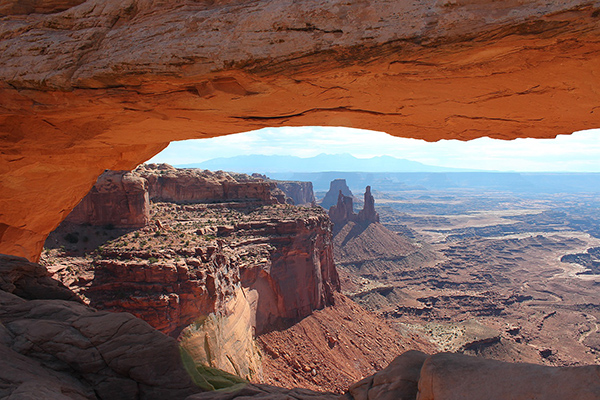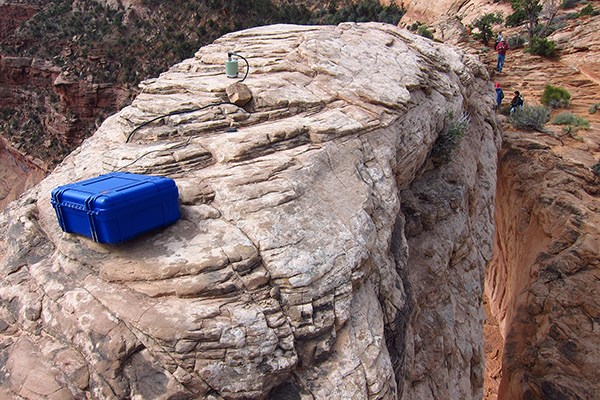
by Abbey Nastan Wednesday, May 11, 2016

Researchers applied structural health monitoring to study the stability of a natural arch — Mesa Arch in Utah's Canyonlands National Park — for the first time in a recent study. Credit: Jeffrey Moore
For decades, structural engineers have listened to the tiny vibrations of buildings and bridges to detect internal damage or weakness. In recent years, geoscientists have begun employing this technique, called “structural health monitoring,” to discover the hidden inner workings of natural rock features. In a recent study, researchers have applied this method for the first time to examine a rock arch — Utah’s famous Mesa Arch — to determine whether this delicate structure is stable or soon to collapse.
The frequencies at which a structure — natural or manmade — vibrates are determined by its shape, density, and stiffness. If cracks form inside the structure, it effectively becomes less stiff, which causes the vibrational frequencies to decrease. Therefore, a drop in frequency can be a good predictor of collapse. Previously, geoscientists observed a frequency drop several weeks in advance of the fall of a natural rock column in France, but overall the technique is still largely untested in natural features.
Natural arches, due to their beauty and relative scarcity, attract considerable tourism, so the collapse of an arch is both an aesthetic loss and a possible hazard to people. Arches National Park in eastern Utah was forced to close a trail under the popular Landscape Arch after large slabs fell from it in 1991 and 1995. Mesa Arch, meanwhile, in nearby Canyonlands National Park, is one of the most photographed arches in the world.
Evaluating the health of such a premier attraction provides invaluable information, but is also challenging because researchers must avoid interfering with tourism and the integrity of the arch itself, says Jeffrey Moore, a geologist at the University of Utah and a co-author of the study, published in Geophysical Research Letters. “We needed a technique that was non-destructive and non-invasive,” Moore says. So, rather than installing permanent sensors, the team measured the arch’s vibrations using small portable seismometers.

To distinguish the unique frequencies of Mesa Arch's humming from background vibrational "noise," scientists set up one seismometer at various positions on the arch and another about 100 meters away on solid ground. Credit: Jeffrey Moore
It was also unclear whether he and his colleagues would be able to pick out Mesa Arch’s distinct signature in the data, Moore says. “Luckily, the arches are really good resonators,” says Alison Starr, the lead author of the study who completed the work while a master’s student at the University of Utah.
To distinguish the unique frequencies of the arch’s humming from background vibrational “noise,” they set up one seismometer at various positions on the arch and another about 100 meters away on solid ground. They recorded data every two months between September 2013 and October 2014, and also in May 2015, taking many repeat measurements to establish whether the frequencies of the arch were changing. Additional measurements allowed the team to account for the effects of daily and seasonally varying temperatures and humidity, as well as subtle changes in the shape of the arch.
The team was able to correlate small variations in the vibrational frequencies observed in the arch with changes in the rock temperature, which in turn caused small but measureable changes in its shape. Over the year-plus they observed Mesa Arch, however, the team saw no permanent shifts in the frequencies of its vibrations that would indicate damage. With a baseline now established, Moore says, “we can come back in a year, or even 10 years, or after an earthquake and actually quantify if something has changed.”
The new results show that structural health monitoring “is well adapted for natural arches,” says Clara Levy, a researcher at France’s Geological and Mining Research Bureau who has previously studied the frequencies at which natural rock columns vibrate. However, Levy says, to prove that the method can be useful in safety management, scientists first need to observe an arch just prior to collapse: “If you want to learn how to differentiate between frequency shifts related to reversible effects or to internal damage, you have to observe internal damage.”
Moore agrees, and says that in the future, he and his colleagues intend to extend their studies to other arches, perhaps installing semi-permanent sensors on a less-visited arch. In addition to characterizing differences between arches, “we could record all the things that happen to an arch, [including] rainstorms, snowstorms and distant earthquakes” to see how they affect the features. If they are unable to witness an arch collapse, he says they could use laboratory experiments to provide insight into the vibrational signatures of damage in an arch. Ultimately, he notes, the data they collect could help park managers ensure the safety of visitors and conserve the wonderful natural formations for future generations.
© 2008-2021. All rights reserved. Any copying, redistribution or retransmission of any of the contents of this service without the expressed written permission of the American Geosciences Institute is expressly prohibited. Click here for all copyright requests.